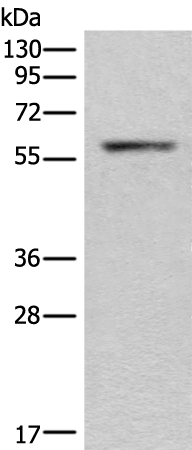
| WB | 咨询技术 | Human,Mouse,Rat |
| IF | 咨询技术 | Human,Mouse,Rat |
| IHC | 咨询技术 | Human,Mouse,Rat |
| ICC | 技术咨询 | Human,Mouse,Rat |
| FCM | 咨询技术 | Human,Mouse,Rat |
| Elisa | 1/5000-1/10000 | Human,Mouse,Rat |
| Aliases | NDP52 |
| WB Predicted band size | 52 kDa |
| Host/Isotype | Rabbit IgG |
| Antibody Type | Primary antibody |
| Storage | Store at 4°C short term. Aliquot and store at -20°C long term. Avoid freeze/thaw cycles. |
| Species Reactivity | Human |
| Immunogen | Fusion protein of human CALCOCO2 |
| Formulation | Purified antibody in PBS with 0.05% sodium azide and 50% glycerol. |
+ +
以下是关于CALCOCO2抗体的3篇参考文献及其摘要概括:
---
1. **文献名称**:*The TBK1 adaptor and autophagy receptor NDP52 restricts the proliferation of ubiquitin-coated bacteria*
**作者**:Thurston, T. L., Ryzhakov, G., Bloor, S., von Muhlinen, N., & Randow, F.
**期刊**:*Nature Immunology* (2009)
**摘要**:
本研究通过免疫荧光和Western blot使用CALCOCO2(NDP52)抗体,揭示了其在抗细菌自噬中的作用。NDP52通过招募TBK1激酶,靶向被泛素标记的胞内病原体(如沙门氏菌),促进自噬体形成并限制细菌增殖。
---
2. **文献名称**:*The ubiquitin kinase PINK1 recruits autophagy receptors to induce mitophagy*
**作者**:Lazarou, M., Sliter, D. A., Kane, L. A., et al.
**期刊**:*Nature* (2015)
**摘要**:
利用CALCOCO2抗体,研究者证明CALCOCO2/NDP52与OPTN协同参与PINK1/Parkin介导的线粒体自噬。实验显示,CALCOCO2通过结合泛素链和LC3蛋白,促进受损线粒体的清除,支持其在选择性自噬中的关键功能。
---
3. **文献名称**:*CALCOCO2/NDP52 regulates metastatic potential of breast cancer cells via SQSTM1-dependent matrix metalloproteinase expression*
**作者**:Jiang, X., Chen, N. Z., Li, J., et al.
**期刊**:*Oncogene* (2016)
**摘要**:
通过CALCOCO2抗体的免疫组化和Western blot分析,研究发现CALCOCO2通过调控SQSTM1(p62)和基质金属蛋白酶(MMPs)的表达,影响乳腺癌细胞的侵袭和转移能力,提示其作为肿瘤预后标志物的潜力。
---
以上文献均通过CALCOCO2抗体验证了该蛋白在病原体清除、线粒体自噬及癌症转移中的功能,覆盖基础机制与疾病关联研究。
The CALCOCO2 (Calcium-binding and coiled-coil domain-containing protein 2) antibody is a tool used to detect the CALCOCO2 protein, also known as NDP52 (Nuclear dot protein 52). This protein plays a critical role in selective autophagy, particularly in xenophagy (clearance of intracellular pathogens) and mitophagy (degradation of damaged mitochondria). CALCOCO2 acts as an autophagy receptor by recognizing ubiquitin-coated cargo, such as invading bacteria or dysfunctional organelles, and recruiting core autophagy machinery (e.g., LC3/GABARAP proteins) to initiate autophagosome formation. Its coiled-coil domains mediate protein-protein interactions, while its ubiquitin-binding domain targets tagged substrates.
CALCOCO2 antibodies are widely used in research to study autophagy pathways, host-pathogen interactions, and mitochondrial quality control. They enable detection of CALCOCO2 expression, localization, and interactions via techniques like Western blot, immunofluorescence, and co-immunoprecipitation. Dysregulation of CALCOCO2 has been implicated in neurodegenerative diseases, cancer, and infectious diseases, making it a focus for therapeutic exploration. Commercial CALCOCO2 antibodies are typically raised in hosts like rabbits or mice, with validation in knockout models to confirm specificity. These reagents are essential for elucidating the molecular mechanisms of autophagy and its role in cellular homeostasis.
×